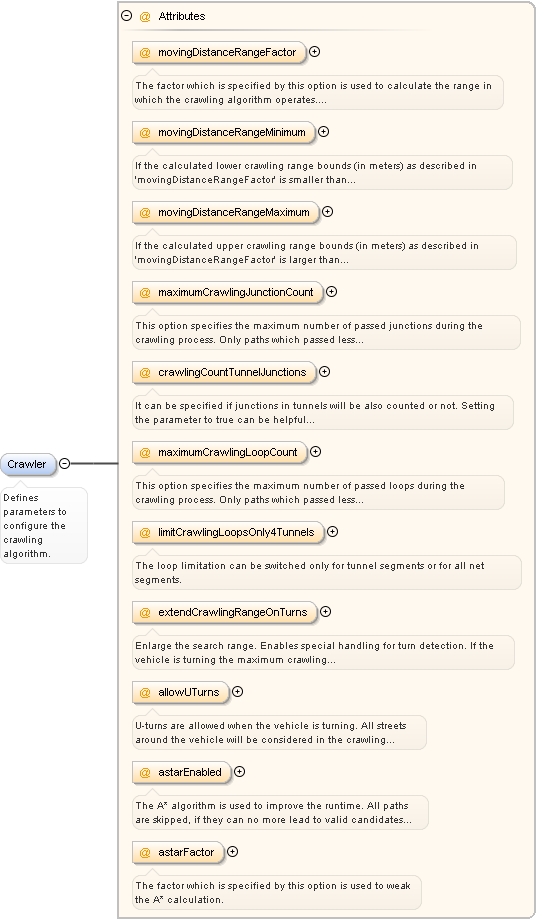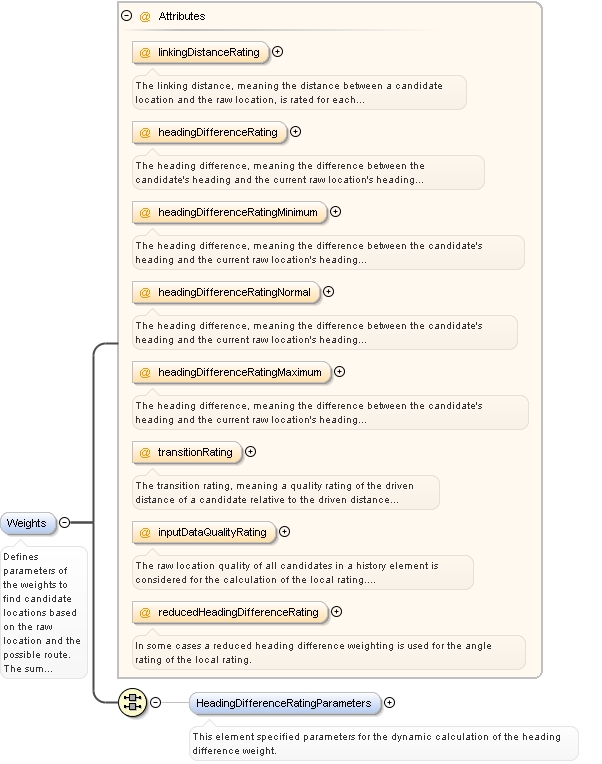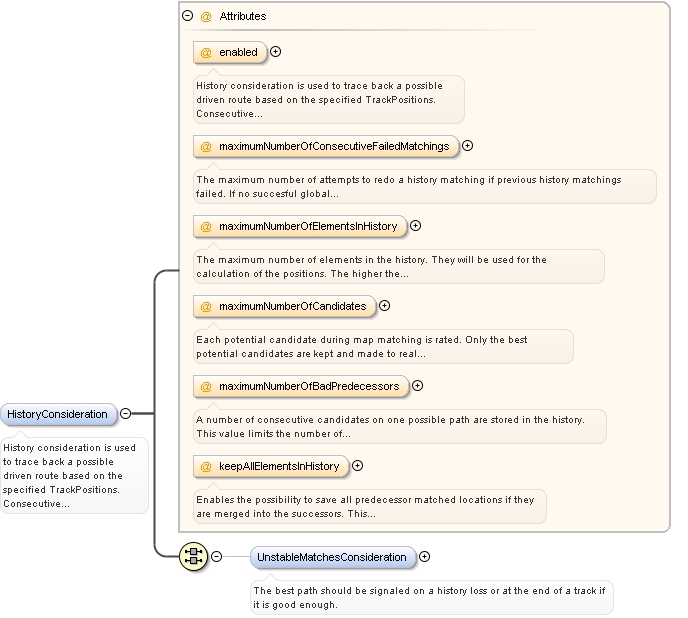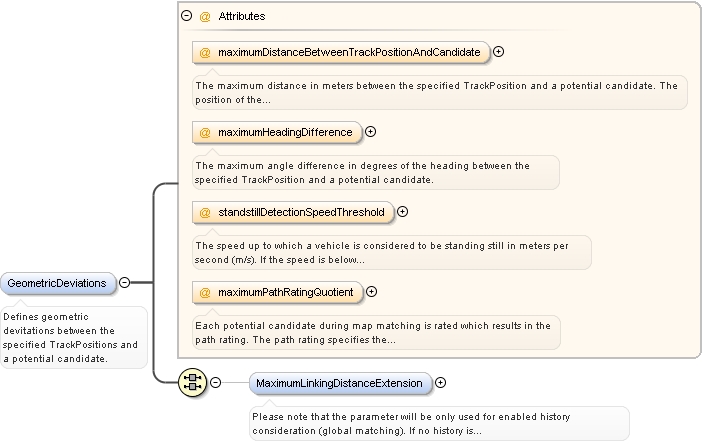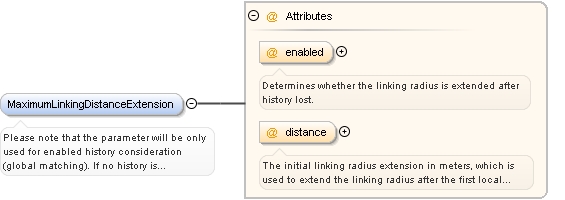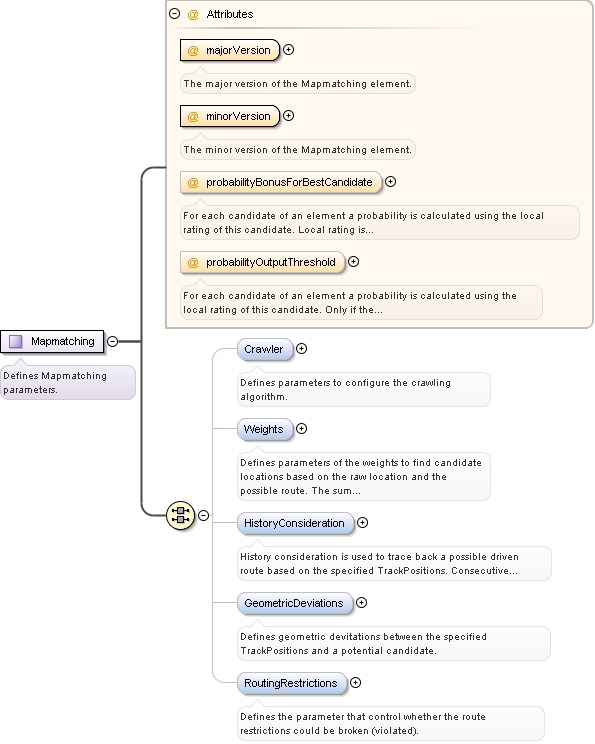|
| Namespace |
No namespace |
|
Annotations
|
Defines parameters of the weights to find candidate locations based on the raw location and the possible route. The sum of all ratings divided by the sum of all weights will result in a value between 0.0 and 1.0 which is named "local rating".
The (effective) heading difference weight can be calculated dynamically for each position with respect to its speed. During slow movement, the given heading from a GPS signal
may deviate strongly from the actual heading, so if the input position provides a low speed, the influence of the heading difference in the final rating can be reduced.
Therefore a normal velocity can be provided as a "reference" speed for which the effective weight is to equal the normal heading difference weight. If the speed decreses,
the effective weight decreases as well, and if the speed increases, the effective weight increases, too. To avoid too extreme variations in the weight, the range is bounded by
configurable minimum and maximum values.
All other weights are fixed to a single value, that can be configured directly. |
|
|
Diagram
|
|
|
Properties
|
| content:
|
complex |
| minOccurs:
|
0 |
|
| Model |
ALL(HeadingDifferenceRatingParameters{0,1})
|
| Children |
HeadingDifferenceRatingParameters |
|
Instance
|
<Weights headingDifferenceRating="0.8" headingDifferenceRatingMaximum="0.8" headingDifferenceRatingMinimum="0.8" headingDifferenceRatingNormal="0.8" inputDataQualityRating="0.0" linkingDistanceRating="0.2" reducedHeadingDifferenceRating="0.25" transitionRating="0.0">
<HeadingDifferenceRatingParameters normalVelocity="0.0">{0,1}</HeadingDifferenceRatingParameters>
</Weights> |
|
|
Attributes
|
| QName |
Type |
Fixed |
Default |
Use |
Annotation |
| headingDifferenceRating |
xs:double |
|
0.8 |
optional |
The heading difference, meaning the difference between the candidate's heading and the current raw location's heading in degrees, is rated for each candidate using the rating function as described in Interpolation points for angle rating.
Must not be set if headingDifferenceRatingMinimum, headingDifferenceRatingNormal, headingDifferenceRatingMaximum or HeadingDifferenceRatingParameters/normalVelocity are set. |
|
| headingDifferenceRatingMaximum |
xs:double |
|
0.8 |
optional |
The heading difference, meaning the difference between the candidate's heading and the current raw location's heading in degrees, is rated for each candidate using the rating function as described in Interpolation points for angle rating.
This attribute specifies the maximal weight of the heading difference for the local rating of a matched location. It is the upper bound for the effective heading difference weight (recalculated for each position by a formula depending on speed) which considers the heading tolerance of a candidate. The calculated heading difference weight never exceeds the value of this maximal heading difference weight. |
|
| headingDifferenceRatingMinimum |
xs:double |
|
0.8 |
optional |
The heading difference, meaning the difference between the candidate's heading and the current raw location's heading in degrees, is rated for each candidate using the rating function as described in Interpolation points for angle rating.
This attribute specifies the minimal weight of the heading difference for the local rating of a matched location. It is the lower bound for the effective heading difference weight (recalculated for each position a formula depending on speed) which considers the heading tolerance of a candidate. The calculated heading difference weight never falls below the value of this minimal heading difference weight. |
|
| headingDifferenceRatingNormal |
xs:double |
|
0.8 |
optional |
The heading difference, meaning the difference between the candidate's heading and the current raw location's heading in degrees, is rated for each candidate using the rating function as described in Interpolation points for angle rating.
This option specifies the normal weight of the heading difference for the local rating of a matched location. It is part of the formula to calculate the effective heading difference weight (recalculated for each position) which considers the heading tolerance of a candidate. The effective heading difference weight can't be greater than the maximal heading difference weight and can't be less than the minimal heading difference weight.
If the driven velocity is equal to the normal velocity, the heading difference weigth is equal to the normal heading difference weight. |
|
| inputDataQualityRating |
xs:double |
|
0.0 |
optional |
The raw location quality of all candidates in a history element is considered for the calculation of the local rating. The raw location quality, which ranges from 0.0 to 1.0, may for example be the quality of a GPS position. The GPS position's quality is bad if there were fewer satellites available for positioning and is good if there are many satellites available. Other location providers may always have a position quality of 1.0. |
|
| linkingDistanceRating |
xs:double |
|
0.2 |
optional |
The linking distance, meaning the distance between a candidate location and the raw location, is rated for each candidate using the rating function as described in interpolation points for distance rating. |
|
| reducedHeadingDifferenceRating |
xs:double |
|
0.25 |
optional |
In some cases a reduced heading difference weighting is used for the angle rating of the local rating. |
|
| transitionRating |
xs:double |
|
0.0 |
optional |
The transition rating, meaning a quality rating of the driven distance of a candidate relative to the driven distance given by the raw location, is calculated for each candidate using the rating function as described in Interpolation points for transition rating. |
|
|
|
|
